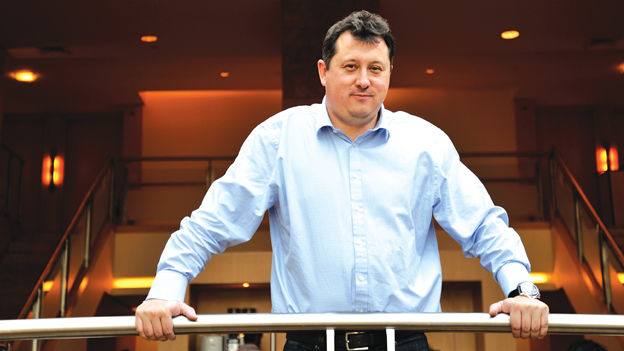Higher education is ripe for disruption

From a banker’s perspective, education is seen as people willingly investing in themselves and their improvement
Q: From business and management consulting, what brought you into the field of education?
A: Careers start making sense when you think backwards! At McKinsey, I specialized in building new companies and later I joined the Standard Chartered bank. Initially, I did not really want to be a consultant, but I joined McKinsey because I couldn’t afford to do an MBA and I thought they would teach me business.
After four years of being in a bank, I realized that I didn’t like running companies but I wanted to build companies. Then, one day Philip Hult (Co-chairman of EF Education First) approached me and proposed a business idea. I was always intrigued about doing something entrepreneurial more than I was driven by education itself and this was an opportunity for my entrepreneurial spirit. Also, I realized that the field of higher education had a lot of competition, but not much innovation. I saw a huge prospect for bringing about a disruption in higher education, while everyone else was only trying to ape Harvard.
Q: What key skills or experiences from your previous assignments have helped you grow this business?
A: Well, McKinsey taught me problem solving and also the importance of communication, while Standard Chartered taught me about leadership as I was managing a vast array of people with varied personalities, behaviors and backgrounds. In addition, both these institutions gave me a sense of speed. My transition into the field of education made some people feel that I was making a mistake. But, education is not a slow-moving space anymore. So, when I joined the institution, there were 15 employees and 90 students and the first thing I did was to put an employee governance structure in place just like any other business would have. It gave us the agility and the ability to move things faster and better. Any innovative initiative we undertook was a result of a market need analysis and a problem solving approach to the need of the hour. From a banker’s perspective, education is seen as people willingly investing in themselves and their improvement. A lot of people may be attracted to a big cheque. However, in education you get actual credit for what you do.
Q: How different is the faculty as a talent pool?
A: What’s most interesting about the faculty is that they are a product in themselves and as individuals they are used to being on their own. Like in McKinsey or Standard Chartered we worked as teams, but most of the faculty are used to working independently. They aren’t necessarily adept at working in teams. It is also one of the reasons why most schools function slow as the capability to take collective and quick decisions gets compromised because of the individualistic culture.
On the contrary, we have tried to build a culture where the faculty can self-select their group activities involving practical exposures, travel and collaborative projects. We have also become a home for practitioners who have valuable practical business experience and are interested in knowledge sharing and knowledge building.
Q: How has your life changed as a part of this new role?
A: The role of a CEO consistently changes as the company grows. Initially, I was doing everything from getting the licences to hiring the team, training them and so on, but now my role has evolved into more of a figurehead. Earlier, my travel schedule used to be driven by problems. It is now driven by people who want to meet me. I spend a lot more time on talent management, interviewing, recruiting and trying to attract people to the school than I spend on problem solving and strategizing as I was doing earlier.
Q: What is your future plan for the school?
A: My first aim, when I took up this role, was to make the school stand out as I did not want it to be just another business school when so many already existed. Having hired many MBAs over the course of my career, I felt that there was a need for education to be much more effective. So to delve a little deeper into understanding this need, we approached the top hundred employers across the globe, talked to CEOs, line managers and HR managers and we found how employers viewed business schools. Employers shared that they hire from the available talent pool, but also provide management trainings to the new hires.
So, as a best practice, we brought back management trainings and built them into a program with 360 degree feedback and simulations to provide our students a real world experience of the corporate world, be it about messy or incomplete data or time pressure or making the right decisions. We also included peer-to-peer coaching and other methods into our curriculum that match the real world management trainings. An essential aim of all our programs is to create a self-awareness around their weaknesses and help them overcome the same.
Q: How do you assess the effectiveness of such a program?
A: In the first month, we make the students involve in some team exercises, do a self-analysis and a 360 degree feedback with their peers. This is then correlated with how they perceive their own strengths, which gets reinforced by their teammates. This exercise confirms that the students actually aren’t as self-aware as one may imagine. Students analyse their strengths and weaknesses against skills that an employer seeks and estimates to decide who is a good, mediocre or a bad performer. Students can look at these characteristics to define how capable they are and identify their improvement areas. The advantage in this exercise is that since the students are in a safe environment, it is easier for them to confront their weaknesses, which otherwise would be very difficult later as a part of a workforce. The next stage is feedback sharing, where students receive constant feedback about their efforts on improvement. Students can self-select two friends who are called ‘navigators’ and share their feedback on each other’s efforts. We encourage constructive feedback as compared to destructive criticism. It is like a formal review and students are trained to be receptive and thankful for any feedback, which they carry forward as a virtue when they get into the corporate world. This in turn helps build coaching as a skill in the students.
Q: What are some other unique aspects of the curriculum?
A: We also have simulations that bring together everything learnt in the MBA. These are multi-functional simulations with teams competing within the campus. These exercises reveal how behaviours of people change when they are under pressure. There are 7 simulations throughout the MBA, which provide real time lessons on crisis management, decision making, communication, strategizing, media handling etc. Another innovation is that we make students work as part of a company on a real project during their MBA. They can also choose to take three challenges from companies. The three challenges this time we had were from IBM, Unilever and Philips. The challenge from IBM is to think of new ways to differentiate in its futuristic cognitive computing business going forward. Unilever has a challenge to revolutionize its e-commerce business and Philips has asked students to come up with recycling ideas for their lighting products.













